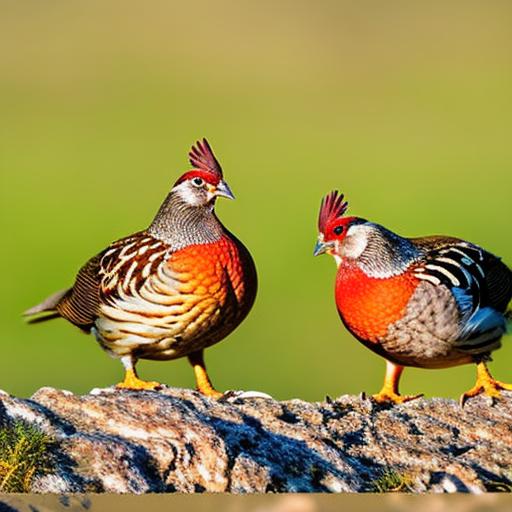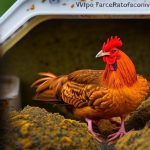Keeping quail and chickens together can be a rewarding and beneficial experience for poultry enthusiasts. Both birds offer unique advantages and challenges, and understanding their differences is crucial for successful cohabitation. In this article, we will explore the benefits and challenges of raising quail and chickens together, as well as provide guidelines for providing adequate space, choosing the right coop, meeting their dietary needs, managing their nesting habits, preventing diseases, and maintaining their overall health and well-being.
Key Takeaways
- Quail and chickens have different needs and behaviors, so it’s important to understand their differences before keeping them together.
- Keeping quail and chickens together can have benefits, such as increased egg production and pest control, but also drawbacks, such as potential aggression and disease transmission.
- Providing adequate space is crucial for the health and well-being of both quail and chickens, and overcrowding can lead to stress and disease.
- Choosing the right coop is important for ensuring the safety and comfort of both quail and chickens, and should take into account their different needs.
- Proper feeding, watering, nesting, and disease prevention are essential for maintaining a healthy and happy flock of quail and chickens.
Understanding the Differences between Quail and Chickens
Quail and chickens differ in terms of their physical characteristics and behavioral patterns. Quail are smaller in size compared to chickens, with a more delicate build. They have a different feather pattern and coloration, making them visually distinct from chickens. In terms of behavior, quail are known to be more flighty and skittish compared to chickens. They are also ground-dwelling birds, while chickens are more comfortable perching and roosting.
These differences can affect their cohabitation in several ways. For instance, the flighty nature of quail may make them more prone to stress when housed with chickens. Additionally, the size difference between the two birds can lead to potential bullying or aggression if not managed properly. It is important to consider these differences when deciding to keep quail and chickens together.
Pros and Cons of Keeping Quail and Chickens Together
There are several advantages to keeping quail and chickens together. Firstly, they can complement each other in terms of foraging habits. Quail are excellent at finding insects and small invertebrates on the ground, while chickens are skilled at scratching the soil for food. By keeping them together, you can create a more efficient pest control system in your garden or backyard.
Another benefit is that they can provide mutual protection against predators. Chickens are larger and more assertive, which can deter potential threats to the flock. Quail, on the other hand, have a keen sense of alertness and can warn the chickens of any approaching danger. This symbiotic relationship can enhance the overall safety of both birds.
However, there are also challenges to consider when keeping quail and chickens together. One major challenge is the potential for aggression or bullying. Chickens may peck at or chase quail due to their size difference, which can cause stress and injury to the quail. It is important to monitor their interactions closely and provide adequate space and resources to minimize any potential conflicts.
The Importance of Providing Adequate Space
Providing enough space is crucial for the health and well-being of both quail and chickens. Overcrowding can lead to stress, aggression, and the spread of diseases. It is recommended to calculate the minimum space requirements based on the number of birds you plan to keep.
For quail, a general guideline is to provide at least 1 square foot of floor space per bird. However, it is always better to provide more space if possible. For chickens, the recommended minimum is 4 square feet of floor space per bird in the coop, and 10 square feet per bird in the outdoor run.
Choosing the Right Chicken Coop for Quail and Chickens
When choosing a coop for quail and chickens, it is important to consider their specific needs. The coop should have features that accommodate both birds comfortably. It should be secure and predator-proof, with proper ventilation to prevent heat buildup and humidity.
In terms of size, the coop should be spacious enough to allow for easy movement and roosting. It should also have separate nesting boxes for both quail and chickens, as they have different nesting habits. Quail prefer ground-level nesting areas with soft bedding material, while chickens prefer elevated nesting boxes with straw or shavings.
Feeding and Watering Requirements for Quail and Chickens

Quail and chickens have different dietary needs, but they can be fed together with some adjustments. Quail require a higher protein diet compared to chickens, as they are more active and have a faster metabolism. A commercial game bird feed with at least 20% protein is recommended for quail, while a standard chicken feed with around 16% protein is suitable for chickens.
It is important to provide separate feeding stations for quail and chickens to ensure that each bird gets the appropriate amount of food. Additionally, waterers should be placed at a height that is accessible to both birds. Quail prefer shallow waterers, while chickens can use standard poultry waterers.
Nesting and Laying Habits of Quail and Chickens
Quail and chickens have different nesting and laying habits. Quail are ground nesters and prefer secluded areas with soft bedding material. They lay small eggs that are usually camouflaged to blend in with their surroundings. Chickens, on the other hand, prefer elevated nesting boxes with straw or shavings. They lay larger eggs that are easily visible.
To accommodate both birds, it is recommended to provide separate nesting areas within the coop. This can be achieved by creating ground-level nesting boxes for quail and elevated nesting boxes for chickens. Providing suitable nesting materials such as straw or shavings will encourage both birds to lay eggs in their designated areas.
Health Risks and Disease Prevention
Quail and chickens are susceptible to various health risks and diseases. It is important to take preventive measures to minimize the risk of illness in your flock. Some common health risks include respiratory infections, parasites, and nutritional deficiencies.
To prevent diseases, it is crucial to maintain good hygiene in the coop and regularly clean and disinfect the area. Quarantining new birds before introducing them to the flock can also help prevent the spread of diseases. Additionally, providing a balanced diet and access to clean water will help boost the immune system of both quail and chickens.
Managing the Flock: Care and Maintenance
Keeping quail and chickens together requires regular care and maintenance tasks. Daily tasks include checking for any signs of illness or injury, providing fresh food and water, and collecting eggs. It is also important to keep the coop clean by regularly removing droppings and replacing bedding material.
Maintaining good hygiene is crucial for the health of both birds. Regularly cleaning and disinfecting the coop will help prevent the spread of diseases. It is also important to provide proper ventilation to prevent the buildup of ammonia from droppings, which can be harmful to the respiratory system of both quail and chickens.
Is Keeping Quail and Chickens Together Right for You?
In conclusion, keeping quail and chickens together can be a rewarding experience if done properly. Understanding their differences, providing adequate space, choosing the right coop, meeting their dietary needs, managing their nesting habits, preventing diseases, and maintaining their overall health and well-being are all crucial factors to consider.
Before deciding to raise quail and chickens together, it is important to weigh the pros and cons based on your specific situation and preferences. If you have enough space, resources, and time to dedicate to their care, keeping quail and chickens together can provide mutual benefits and enhance your poultry-keeping experience.
If you’re considering keeping quail and chickens together, you may be wondering if quails sit on their eggs like chickens do. To find out more about this topic, check out this informative article on Poultry Wizard: “Do Quails Sit on Their Eggs?” This article explores the nesting behavior of quails and provides insights into whether they exhibit brooding behavior similar to chickens. Understanding the egg-sitting habits of quails is essential for successful breeding and egg production in a mixed poultry flock. To learn more, click here: https://poultrywizard.com/breeding-quail/do-quails-sit-on-their-eggs/.
FAQs
What are quails and chickens?
Quails and chickens are both domesticated birds that are commonly raised for their meat and eggs. Quails are smaller in size compared to chickens and have a unique appearance with their speckled feathers and round bodies.
Can quails and chickens be kept together?
Yes, quails and chickens can be kept together in the same coop or pen. However, there are certain considerations that need to be taken into account to ensure the safety and well-being of both species.
What are the considerations when keeping quails and chickens together?
One of the main considerations is the size of the coop or pen. Quails require less space compared to chickens, so it is important to ensure that there is enough space for both species to move around comfortably. Additionally, quails are more prone to stress and can be easily bullied by chickens, so it is important to provide hiding places and separate feeding areas.
What are the benefits of keeping quails and chickens together?
Keeping quails and chickens together can provide a number of benefits. For one, it can help to reduce the risk of pests and predators as both species can work together to keep the area clean and safe. Additionally, it can be more cost-effective to keep both species together as they can share the same feed and water sources.
Are there any risks to keeping quails and chickens together?
Yes, there are some risks to keeping quails and chickens together. As mentioned earlier, quails are more prone to stress and can be easily bullied by chickens. Additionally, there is a risk of disease transmission between the two species, so it is important to monitor their health and hygiene closely.
Meet Walter, the feathered-friend fanatic of Florida! Nestled in the sunshine state, Walter struts through life with his feathered companions, clucking his way to happiness. With a coop that’s fancier than a five-star hotel, he’s the Don Juan of the chicken world. When he’s not teaching his hens to do the cha-cha, you’ll find him in a heated debate with his prized rooster, Sir Clucks-a-Lot. Walter’s poultry passion is no yolk; he’s the sunny-side-up guy you never knew you needed in your flock of friends!







